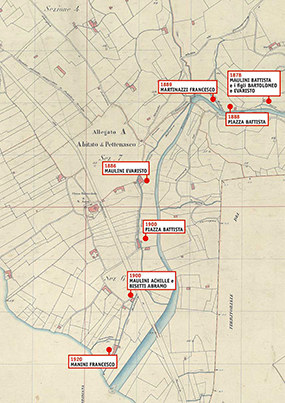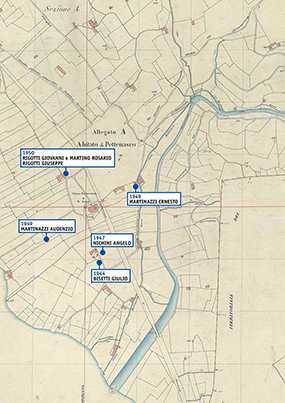History of the wood turning workshops
The craft of wood turning is part of ancient tradition for the village of Pettenasco.
In the year 1700 there were already five mills powered by the force of the Pescone brook and the Roggia Molinara, a man-made canal that breaks off from the main waterway at the entrance to the Fatta Valley.
By 1800 the mills were no longer used for flour milling, but rather were transformed for use in woodworking shops. The local residents began to call these building “factories” and the lathe turners were nicknamed “gratagamul”, or “woodworm graters”.
The motor force required to move the complicated machinery came from the force of the flowing water. Large wooden wheels were positioned under the various waterfalls along the course of the Pescone brook and the Roggia Molinara. These water wheels operated the inner gears that set the artisans’ lathes and circular saws in motion.
By 1922 there were a good seven wood turning workshops active in Pettenasco: Bezzi Fratelli (Bezzi Brothers), Maulini Bartolomeo, Maulini Evaristo, Manini Francesco, Albini and Bisetti, Martinazzi Francesco, and Piazza Battista (Baptist Square).
During the 60s and 70s, the woodworking craft was abandoned, mainly due to the widespread use of plastic as a raw material for all kinds of manmade objects. Some artisans today still work with wood, using modern tools and equipment and producing high design objects or unique furniture and accent pieces.
 (cliccare sull'immagine per ingrandire) (cliccare sull'immagine per ingrandire) |
1878/1879: First settlement by Maulini Battista with his sons Bartolomeo and Evaristo. His two sons learned the craft from the expert craftsmen of the Strona Valley and opened their studio in the Fatta Valley (in the Folla territory), using hydraulic power from the first stretch of the Roggia Molinara.
1886: Evaristo Maulini chose to separate himself from his brother Bartolomeo and gave life to a new wood turning workshop located further down the valley, using energy produced by the second part of the Roggia Molinara.
1888: Battista Piazza, originally located in the Strona Valley (which already held another factory), moved to the Fatta Valley. Thanks to its workers’ knowledge of metal fusion, this studio found its niche in the market by playing on the combination of wood and metal to produce pepper and coffee grinders.
1889: Francesco Martinazzi, also from the Strona Valley, began production in a factory on a plot of land adjacent to the Piazza factory. At the beginning of the century, the Battista Piazza moved once again, further down the Roggia Molinara valley, and began construction on the plant that would become in the 1930s one of the largest Italian complexes of its kind.
1911: The Nazzaroli wood turning factory in Pescone di Agrano began production.
1920: Bezzi Gesuino and Bartolomeo created a studio in the Vicolo Station.
1917-1921: At the intersection of the Roggia Molinara and the state road, the Oglina family established a new settlement, where Crotta, Abramo Bisetti, and Achille Maulini would eventually all work.
1920-1921: The Manini Francesco wood turning workshop was founded on the last usable stretch of the Roggia Molinara. This is the only such factory that is still productive, where Giovanni and Giuseppe, Francesco’s son and grandson respectively, work to this day.
With the introduction of new technologies and the use of new energy sources, new establishments have popped up in various other locations that don’t rely on the primitive hydraulic power supplied by the Roggia Molinara.
 (cliccare sull'immagine per ingrandire) (cliccare sull'immagine per ingrandire) |
1944: Giulio Bisetti opened a wood turning workshop that specialized in the creation of toys and household items (including his coffee grinder that went on to win the “Cusiani Benemeriti”).
1947: The Angelo Nichini wood turning workshop was opened.
1949: The Ernesto Martinazzi wood turning workshop was opened.
1949: The Francesco Martinazzi house was acquired by his grandchildren Audenzio and Giovanna Martinazzi. They transformed it into a modern workshop and moved it out of the Fatta Valley.
1950: Giovanni Rigotti, Giuseppe Rigotti, and Rosario Martino founded a new wood turning workshop on Via Legro.
1955: Giuseppe Rigotti opened up his own wood turning workshop in Pratolungo that would be the only such establishment in the Pettenasco community.
1977: Giordano and Audenzio Nichini purchased the Martinazzi brothers’ workshop.
- Top of page -


